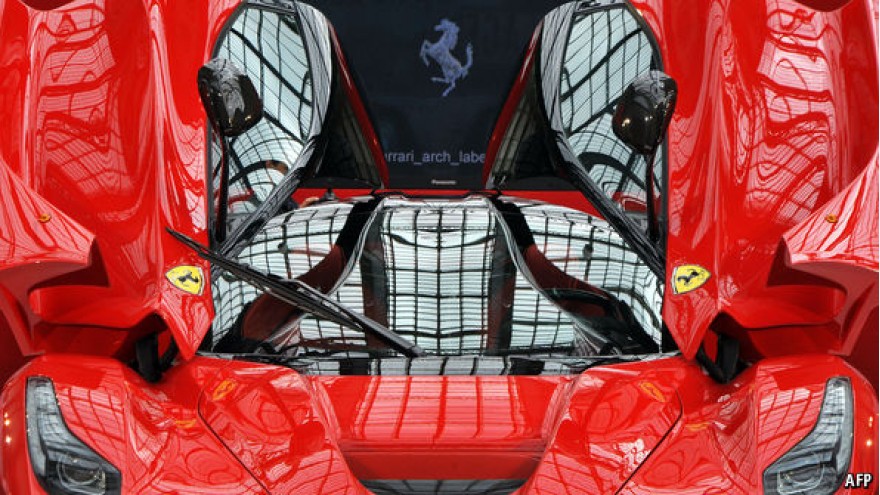Wheel Spin Off
Squeezing every ounce of performance out of Ferrari is important. Selling 10% of the firm in an IPO in New York, which is expected early next week, will help to pay for Fiat Chrysler’s ambitious investment plans. (Fiat Chrysler’s investors will eventually get 80% of the stock; a Ferrari family member owns the other 10%.) At the upper end of the price range Ferrari would be worth nearly €10 billion, half the value of Fiat Chrysler itself. Sceptics, who regard Ferrari as just a carmaker, albeit a successful one, reckon it is worth €6 billion.
AT AROUND €1.4m ($1.6m) LaFerrari, the flagship model of the Italian supercar-maker (pictured), is expensive. It is exclusive too; just 499 will roll off the production line. Jet-fighter styling and doors that scissor upwards add to the extravagance. The car appears to lend credibility to the argument of its parent, Fiat Chrysler (whose chairman, John Elkann, sits on the board of The Economist’s parent company), that Ferrari deserves a loftier valuation, at its initial public offering this month, as a luxury-goods firm, not a lesser one as a carmaker.
Few would argue with Sergio Marchionne, boss of Fiat Chrysler, that Ferrari is “unique”. Its prancing-horse logo is recognised around the world. It sells around 7,000 cars a year, nearly three times as many as Lamborghini, a rival owned by Volkswagen. The least expensive Ferrari costs some €180,000. The firm has consistently turned a profit and, for the car industry at least, makes a handsome operating margin of 14-16%.
But is this enough to propel Ferrari into the ranks of luxury-goods firms? A production cap preserves exclusivity but limits growth. Other carmakers may envy its margins, but they are some way below those of luxury firms such as Hermès or Prada. The main difference, however, is the level of investment required to launch new models regularly.
Developing a new car is far more expensive than designing a handbag, and making supercars is capital-intensive. Ferrari spent €541m, a fifth of its revenues, on research and development in 2014 (though it is unclear how much of this went on its Formula 1 motor-racing team); capital spending accounted for another 12% of revenues. Moreover, luxury goods can have a longer shelf life. Chanel’s best-selling handbag was designed in 1955; each Ferrari model has an eight-year lifespan.
Some of Ferrari’s claims, however, have oomph. Unlike Ferrari, luxury firms spend heavily on fancy shops in swanky locations. Filling glossy magazines with pages of advertising is also costly. F1 is Ferrari’s only marketing tool. Running a racing team is expensive but prize money and a cut of F1’s revenues help it to break even.
The firm may yet boost revenues and margins both from cars and extending its brand to other products. A new cheaper model, the “Dino”, is planned. Other ventures adjacent to carmaking are not inconceivable—the Ferrari badge once adorned flash speedboats. There is scope to make more from merchandise, which brings profits of $50m a year and is currently aimed mainly at fans of the F1 team. Ferrari may try to emblazon its logo on more expensive items than baseball caps and polo shirts. But will rich punters covet, say, a Ferrari watch costing thousands of dollars?
Such rational calculations may miss the point, however. Those who question the necessity of a car that can break speed limits three times over may also underestimate the desire of trophy-hunting investors to own Ferrari shares.





Comments